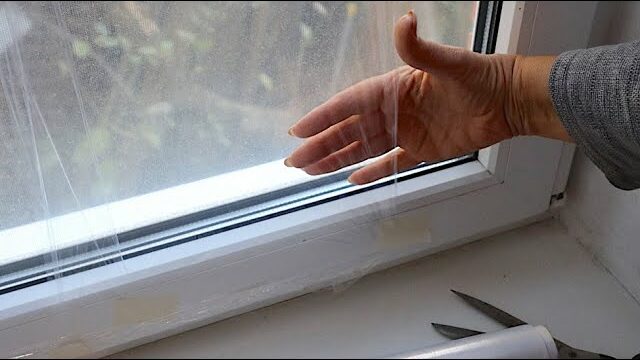
Applying cling film to windows is a simple yet effective method to enhance the insulation of your home, especially during colder months. This makeshift approach can significantly increase warmth inside, much like double-glazing, but at a fraction of the cost. Here’s how it works and why you might consider trying it for your own home.
How Cling Film Improves Home Warmth
**1. Air Insulation: Cling film creates an additional layer of insulation by trapping a layer of air between the window glass and the film itself. This trapped air acts as a buffer that reduces the transfer of heat through the window, helping to maintain a warmer indoor environment.
**2. Reduces Drafts: By sealing off potential gaps around window frames with cling film, you can minimize cold drafts that might otherwise enter your home. This not only keeps the space warmer but also helps in reducing heating costs as your heating system doesn’t need to work as hard to maintain a comfortable temperature.
**3. Increases Energy Efficiency: Improving window insulation with cling film can lead to significant energy savings. With better heat retention, there’s less need for continuous heating, thereby lowering energy consumption and utility bills.
How to Apply Cling Film to Windows
**1. Clean the Window: Before applying cling film, ensure the window glass is clean and dry. Any dirt or moisture can prevent the film from adhering properly.
**2. Cut and Apply the Film: Measure the window and cut a piece of cling film slightly larger than the window pane. Attach the film to the window frame, starting from the top and working your way down. Use tape or a hair dryer to secure and shrink-fit the film onto the window for a tighter seal.
**3. Seal Edges: Use double-sided tape or clear tape to seal the edges of the cling film to the window frame. This helps create an air-tight seal that maximizes insulation.
**4. Smooth Out Wrinkles: Use a squeegee or a smooth, flat object to press out any air bubbles or wrinkles, ensuring the film is as flat and smooth as possible.
Considerations and Tips
- Temporary Solution: Keep in mind that cling film is a temporary solution. It might not be as durable or visually pleasing as professional weatherproofing options.
- Light and Visibility: Applying cling film may slightly reduce the clarity and amount of natural light passing through the window. Consider this if natural lighting is important in your space.
- Alternative Options: For a more durable solution, consider using insulating window film designed for this purpose, which can be more aesthetically pleasing and effective.
Conclusion
Using cling film on your windows is a surprisingly effective way to enhance the warmth and energy efficiency of your home without significant investment. This method can be particularly useful for renters or those on a budget who are looking for a quick fix to keep their homes warmer in the winter months. Give it a try and feel the difference it can make in making your living space more comfortable and cost-efficient.



